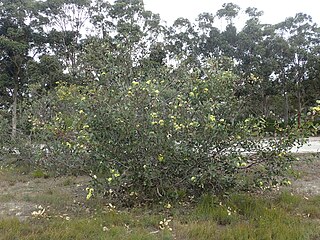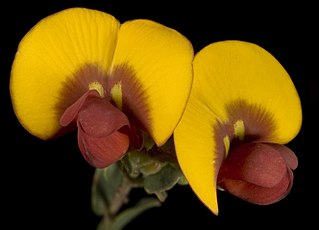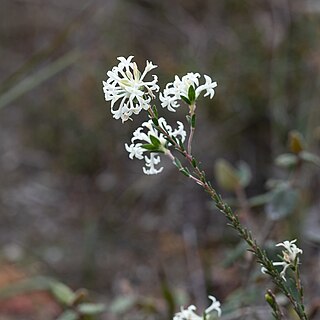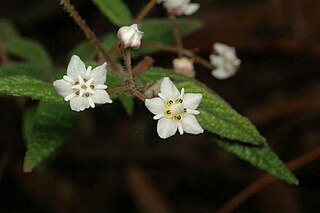
Eucalyptus preissiana, commonly known as bell-fruited mallee, is a species of small tree or shrub that occurs in an area between Albany and Esperance in Western Australia. It has a spreading habit, smooth bark, elliptical to egg-shaped or oblong leaves, flower buds in groups of three, yellow flowers and cup-shaped, conical or bell-shaped fruit.

Grevillea obtusifolia, commonly known as obtuse leaved grevillea, is a species of flowering plant in the family Proteaceae and is endemic to the south-west of Western Australia. It is a spreading to dense, prostrate shrub with oblong to narrowly elliptic leaves and clusters of eight to twelve, pink or red flowers.

Grevillea umbellulata is species of flowering plant in the family Proteaceae and is endemic to the south-west of Western Australia. It is a spreading shrub that forms a lignotuber, has linear to narrowly elliptic leaves, and cylindrical clusters of hairy, white to cream-coloured flowers often tinged with grey or pink.

Lasiopetalum behrii, commonly known as the pink velvet bush, is a species of flowering plant in the family Malvaceae and is endemic to southern continental Australia. It is an erect shrub with lance-shaped, narrowly oblong to narrowly elliptic leaves and groups of white to pink and reddish-brown flowers.

Grevillea diversifolia, the variable-leaved grevillea, is a species of flowering plant in the family Proteaceae and is endemic to the south-west of Western Australia. It is an erect to prostrate shrub with simple or divided leaves and groups white to cream-coloured flowers with a dull red style.
Verticordia lehmannii is a flowering plant in the myrtle family, Myrtaceae and is endemic to the south-west of Western Australia. It is slender shrub with only a few branches, well-spaced, oppositely arranged leaves and small heads of pale pink to silvery flowers with a dark pink centre.

Boronia stricta is a plant in the citrus family, Rutaceae and is endemic to near-coastal areas of the south-west of Western Australia. It is a slender shrub with often crowded pinnate leaves with linear leaflets, and pink, four-petalled flowers borne singly or in groups of two or three in leaf axils.

Thomasia angustifolia, commonly known as narrow-leaved thomasia, is a species of flowering plant in the family Malvaceae and is endemic to the south-west of Western Australia. It has densely hairy young stems, narrowly oblong, wrinkled leaves and pinkish-purple, bell-shaped flowers.

Bossiaea pulchella is a species of flowering plant in the family Fabaceae and is endemic to the south-west of Western Australia. It is a slender, erect shrub with egg-shaped leaves, and orange-yellow, purplish brown and dark red flowers.
Bossiaea spinescens is a species of flowering plant in the family Fabaceae and is endemic to the south-west of Western Australia. It is a slender, spreading or compact, spiny shrub with oblong to oval leaves and yellow and reddish-brown, pea-like flowers.

Eutaxia cuneata is a species of flowering plant in the family Fabaceae and is endemic to the south-west of Western Australia. It is a slender, upright shrub with red and orange pea-like flowers.

Lasiopetalum drummondii is a species of flowering plant in the family Malvaceae and is endemic to the south-west of Western Australia. It is an erect, slender shrub with many densely hairy stems, egg-shaped or oblong leaves and white, pink and red flowers.
Lasiopetalum indutum is a species of flowering plant in the family Malvaceae and is endemic to the south-west of Western Australia. It is an erect or straggling shrub with hairy stems and pink, cream-coloured or white flowers.
Lasiopetalum membranaceum is a species of flowering plant in the family Malvaceae and is endemic to near-coastal areas of south-western Western Australia. It is an erect, spreading shrub or subshrub with hairy young stems, egg-shaped leaves and mauve-pink and dark red flowers.
Olearia lehmanniana is a species of flowering plant in the family Asteraceae and is endemic to inland areas of the south-west of Western Australia. It is a shrub with scattered elliptic or linear leaves that are densely hairy on the lower surface, and pale mauve, daisy-like inflorescences.

Leucopogon flavescens is a species of flowering plant in the heath family Ericaceae and is endemic to the south-west of Western Australia. It is a shrub with oblong leaves and white, tube-shaped flowers that are densely bearded on the inside.
Thomasia rulingioides is a species of flowering plant in the family Malvaceae and is endemic to the south-west of Western Australia. It is an erect, open shrub with densely hairy new growth, narrowly oblong to narrowly egg-shaped leaves with wavy edges, and pink to purple flowers.

Pimelea phylicoides, commonly known as heath rice-flower, is a species of flowering plant in the family Thymelaeaceae and is endemic to southern continental Australia. It is an erect shrub with densely hairy young stems, narrowly egg-shaped to elliptic leaves, and heads of white flowers surrounded by 3 to 6 involucral bracts.

Commersonia rugosa is a species of flowering plant in the family Malvaceae and endemic to New South Wales. It is an open, straggly shrub with linear to narrowly egg-shaped leaves with irregular teeth or lobes on the edges, and white flowers in clusters of 3 to 15.

Pimelea tinctoria is a species of flowering plant in the family Thymelaeaceae and is endemic to the south-west of Western Australia. It is an erect, spindly shrub with elliptic leaves arranged in opposite pairs, and compact heads of many yellow or yellowish-green flowers usually surrounded by 4 to 7 pairs of egg-shaped to narrowly elliptic yellow and green involucral bracts.















